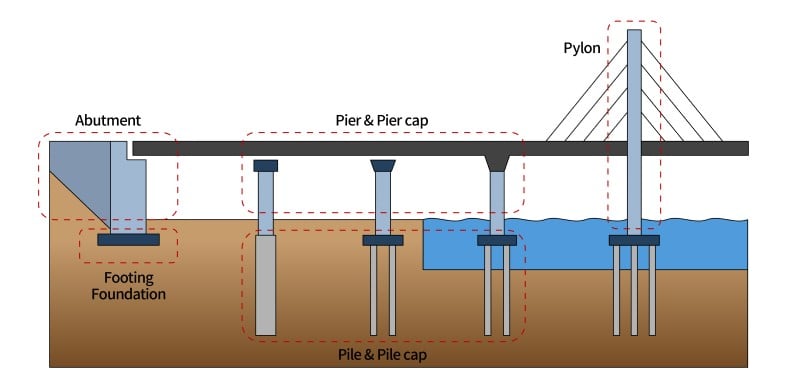1. What is Substructure?
As shown in the figure below, there are many different types and forms of Substructures, and the design and analysis methods vary accordingly. However, each type and form of substructure is intended to withstand the load transmitted from the superstructure while allowing the bridge to be constructed at the desired height (design level).
The substructure is determined by considering the type of superstructure, construction method, ground conditions, and aesthetic factors. Conversely, the layout plan of the substructure, according to the surrounding roads or ground conditions, is the biggest factor in determining the span length of the superstructure. Therefore, instead of planning the two parts separately, the whole structure should be reviewed and planned as one system.

/09.%20Substructures/Figure/Substructure_figure_Bridge%20Abutment.jpg)
/09.%20Substructures/Figure/Substructure_figure_Abutment%20Components.jpg)
/09.%20Substructures/Figure/Substructure_figure_Types%20of%20Instability%20Failure%20of%20Abutment.jpg)
/09.%20Substructures/Figure/Substructure_figure_Loads%20for%20Abutment%20Design.jpg)
/09.%20Substructures/Figure/Substructure_figure_Hammerhead%20Pier.jpg)
/09.%20Substructures/Figure/Substructure_figure_Pier%20cap%20With%20Parabolic%20Haunches.jpg)
/09.%20Substructures/Figure/Substructure_figure_Cantilever%20Pier%20(Cantilever%20Pier%20cap).jpg)
/09.%20Substructures/Figure/Substructure_figure_Rigid%20Frame%20Pier.jpg)
/09.%20Substructures/Figure/Substructure_figure_Solid%20Wall%20Pier.jpg)
/09.%20Substructures/Figure/Substructure_figure_Strut-and-Tie%20Model%20for%20Pier%20Cap.jpg)
/09.%20Substructures/Figure/Substructure_figure_Strut-and-Tie%20Model%20for%20Pile%20cap.jpg)


